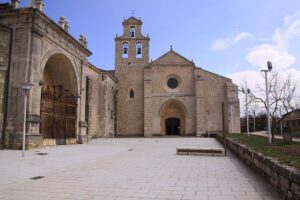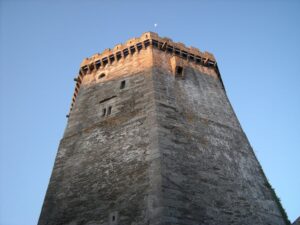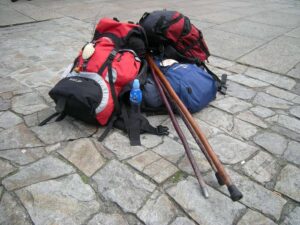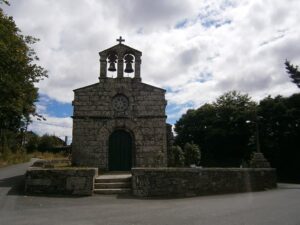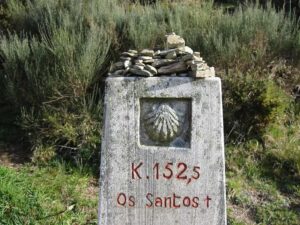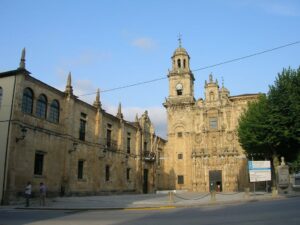
Around 30 kilometres from Burgos, there stands a site that, although modest in appearance, has been one of the most iconic refuges along the Camino de Santiago for centuries: the Monastery of San Juan de Ortega. Located along one of the key stages of the Camino Francés, this Romanesque monastic complex stands out for its architectural value and the profound symbolic significance it represents.
San Juan de Ortega, a disciple of the legendary Santo Domingo de la Calzada, dedicated his life to facilitating the pilgrimage through one of the most inhospitable areas of the Jacobean route. In the early 12th century, he ordered the construction of a church and a hospital here to care for the pilgrims, turning a lonely spot into a place of rest and protection.
Over the centuries, the monastery has witnessed wars, reforms, abandonments, and recoveries. Despite all this, its essence remains intact: that of being a sanctuary of spirituality in the midst of the journey.
This article explores the history, present, and spiritual legacy of San Juan de Ortega, a place that is not only passed through, but truly lived. Because there are places that, beyond their location, mark a turning point in the pilgrim’s inner journey. And this monastery is undoubtedly one of them.
Índice de contenidos
San Juan de Ortega: the legacy of a holy man in service to the pilgrim
Juan de Quintanaortuño was born in the middle of the 11th century in a small village in Burgos. His life was marked by religious vocation and service to others, especially the pilgrims who crossed the mountains and moors of northern Spain on their way to Santiago de Compostela.
He was a disciple and collaborator of Santo Domingo de la Calzada, with whom he shared not only the Christian ideal but also the concern for improving the infrastructure of the Camino. Together, they worked on the construction of bridges, roads, and hospitals during a time when walking long distances exposed one to hunger, disease, and violence.
After the death of his master, Juan continued this mission on his own. After a pilgrimage to Jerusalem, he retreated to the Montes de Oca —a nearly uninhabited and considered dangerous area at the time— and founded a small monastery with a church and hostel, dedicated to Saint Nicholas of Bari. Over time, this site would come to bear his name.
The definitive boost came in 1142, when King Alfonso VII donated land and privileges to the monastery, solidifying its role as a strategic point on the Camino Francés. In addition to offering care to travellers, the site also became a centre for the spread of Jacobean devotion and the reorganisation of the territory.
San Juan died in 1163 and, although he was never officially canonised by Rome, his local veneration was immediate. Evidence of this is that his tomb, located inside the Romanesque church he ordered to be built, quickly became a secondary pilgrimage site.
Over time, his figure has been associated with the protection of pilgrims. In fact, one of the oldest popular devotions linked to the monastery is the one that presents him as an intercessor for fertility problems and difficult pregnancies. Until the 20th century, it was common for women from the entire region to visit his tomb to seek his help in childbirth.
Thus, the story of San Juan de Ortega cannot be understood apart from the Camino de Santiago. His life and work embody the hospitable spirit that still defines this ancient route: selfless care, faith embodied in concrete actions, and a deep belief that helping others is also advancing on one’s own path.
The monastery today

Current state of the monastery and recent reforms
After centuries of partial abandonment and deterioration, the monastery has undergone significant restoration efforts in recent decades. Declared a Heritage of Cultural Interest, it has been the subject of several restoration campaigns promoted by the Regional Government of Castilla y León, the Archdiocese of Burgos, and organisations related to the heritage of the Camino.
The most prominent interventions have focused on consolidating structures, restoring roofs, recovering the cloister, and improving access. As a result, the complex has regained its architectural dignity and continues to function as a place of worship and hospitality.
Currently, the monastery’s surroundings maintain a balance between the monumental and the rural, with no massive urbanisation.
A Romanesque gem: church, tomb, and cloister
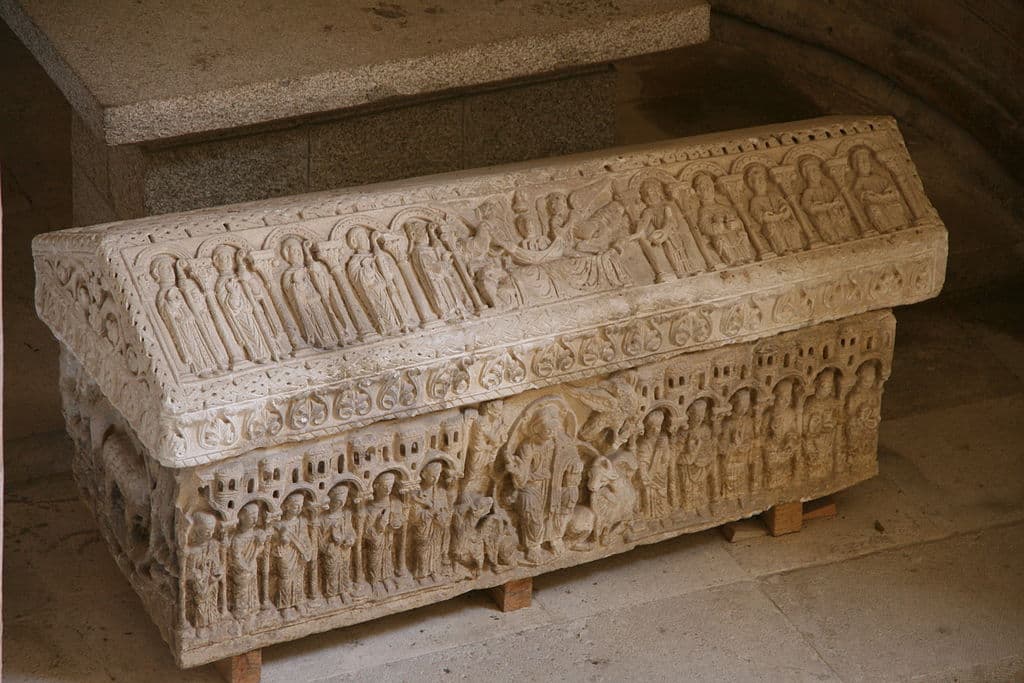
The core of the monastic complex is the Romanesque church, started by San Juan himself and completed in the middle of the 12th century (hence its Gothic details). It is a single-nave building with a transept and a triple apse. Inside, some of the most outstanding sculptural elements of Burgos Romanesque are preserved, such as the capitals with biblical and vegetal scenes.
One of the most interesting points is the tomb of the saint, located on the right side of the presbytery. The tomb, decorated with 15th-century Gothic motifs, was commissioned by Bishop Pedro de Agén, who led one of the temple’s reforms in the Late Middle Ages.
The cloister, although more modest, still retains part of its original structure. Its restoration in recent decades has allowed it to be revalued as a space for contemplation. Around it are the monastic rooms, some of which have been adapted for liturgical and hospitality use.
The equinox light: a phenomenon of faith and geometry
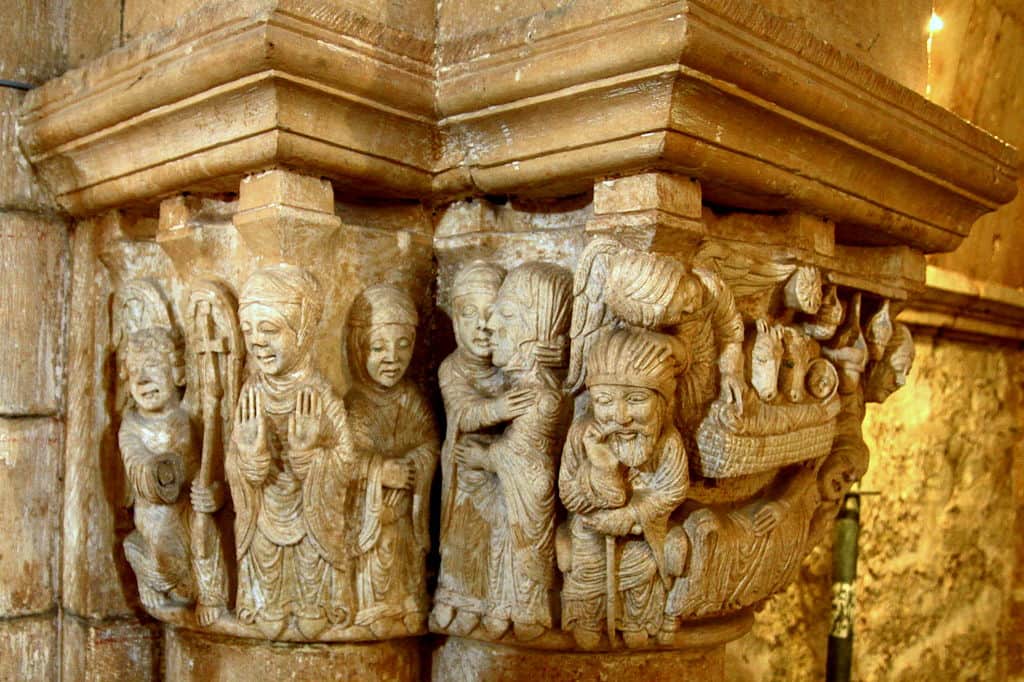
One of the most unique aspects of the monastery is the luminous phenomenon that occurs twice a year, coinciding with the spring and autumn equinoxes. During those days, at sunset, a ray of sunlight enters through a window in the apse and travels across the nave to directly illuminate one of the capitals of the temple, the one depicting the Annunciation.
Beyond being an interesting fact, many interpret this event as a visual metaphor of the inner journey: the light that follows the darkness of the Montes de Oca forest.
Space for silence, prayer, and listening for the pilgrim
San Juan de Ortega is not only a stage of the Camino Francés; it is also a place of contemplation. Its isolated location and the sobriety of its architecture foster introspection. Many pilgrims see it as a spiritual stop, ideal for reflecting on the journey or simply resting in a serene environment.
Why choose the Camino Francés? A comparison with other routes of the Camino de Santiago
One of the main reasons why many pilgrims choose this route is its consolidated infrastructure: hostels, clear signage, cultural offerings, and services for the pilgrim at almost every stage.
In addition, its route allows for a progressive geographical and emotional evolution. The pilgrim moves from the Pyrenean forests to the Castilian plateau, and from there to the green landscapes of Galicia, as an inner journey that accompanies the movement of the body.
However, the Camino Francés is not the only option. Each Jacobean route has its own character, landscapes, and rhythm. Below, we briefly review some of the main alternatives, each with its own appeal.
- Camino del Norte. For those seeking a wilder and less crowded environment, this route offers a journey parallel to the Cantabrian Sea, passing through cities such as Bilbao, Santander, and Gijón. Additionally, it provides a great variety of geography and culture. The Camino del Norte from Santander to Gijón combines heritage, gastronomy, and spectacular coastal landscapes.
This route is physically more demanding, due to the continuous elevation changes and mountain stretches, but in return, it offers a more intimate and solitary experience. It is ideal for those who value contact with nature and silence.
- Camino Portugués. Another increasingly popular route is this one, which crosses the neighbouring country from south to north, starting from Lisbon or Porto. The Camino de Santiago Portugués from Porto to A Guarda represents an excellent combination of history, charming towns, and rural landscapes.
Along the way, the pilgrim encounters baroque churches, Roman roads, ancient wineries, and a welcoming atmosphere. This route stands out for its balance between comfort and tradition, as well as its scenic beauty in the section bordering Galicia.
- Camino Portugués by the Coast. For those who prefer the coastline and the Atlantic breeze, the Camino from A Guarda to Santiago is an excellent alternative. This coastal variant allows walking by the sea, enjoying solitary beaches, and exploring historical sites like Baiona or Vigo before heading inland to Galicia.
Although it has fewer facilities, this route has gained popularity in recent years due to its authenticity and natural beauty. Furthermore, it is less crowded, providing a more introspective experience.
- Camino Primitivo. Its profile is mountainous, with physically demanding stages, especially between Alto del Palo and Lugo. Those who choose this route value silence, effort, and authenticity. The low density of pilgrims, combined with spectacular natural surroundings, makes this option one of the most valued by experienced walkers or those seeking a deeply spiritual experience.
- Camino Inglés. It is an excellent option for those with limited time or who wish to experience their first Jacobean journey. Although short, its history and environment make it a complete route, with well-marked rural and urban sections, and a good network of services.
Camino Francés: the spiritual heart of the Camino
Despite the richness of these alternative routes, the Camino Francés remains, for many, the central axis of the Jacobean tradition. Not only because of its history, but also because of the concentration of symbols and cultural references: the cathedral of Burgos, the passage through the Montes de Oca, the Cruz de Ferro, O Cebreiro… places where spirituality and history come together.
And of course, points like San Juan de Ortega, with its Romanesque monastery and equinoctial light, offer the pilgrim unique moments of silence, reflection, and connection. It is this combination of elements — tradition, hospitality, beauty, rhythm — that makes so many travellers, even after walking other routes, return time and time again to the Camino Francés.
Some opt to do it in stages, others walk the entire route. And many, to enhance the experience without losing authenticity, decide to join a specialised company offering organised Camino de Santiago trips. Without a doubt, a practical way to discover the various routes with safety, planning, and the freedom to walk without worries.
How to visit San Juan de Ortega: practical recommendations
The monastery of San Juan de Ortega is located in the Alfoz de Burgos region, within the municipality of Barrios de Colina, in the Montes de Oca. On foot, you can access it after passing through emblematic towns like Atapuerca and Agés, following the yellow arrows of the Camino.
The equinoctial light: when to witness the solar phenomenon
One of the main attractions of the place is the so-called “miracle of light”. This solar phenomenon occurs only twice a year: around March 21 and September 22, dates that coincide with the spring and autumn equinoxes.
On these days, shortly after 5 p.m. (solar time), a sunbeam enters through a window in the apse of the church and precisely illuminates the capital representing the Annunciation. This effect, the result of a millimetric architectural calculation, lasts only a few minutes, but leaves a profound impression on those present.
If you wish to experience this, it is advisable to arrive early and maintain silence inside the temple.
Where to sleep nearby if you do not stay at the monastery
The San Juan de Ortega hostel has limited capacity and, during peak months (especially between May and September), it can fill up quickly. In that case, a good option is to stay in nearby towns, such as Agés (3.5 km away) or Atapuerca (6 km away), both well connected on foot by the official Camino route.
It is best to plan your itinerary in advance with the help of specialised services, such as those offered by Mundiplus. We help you walk with more flexibility, handle accommodation reservations in advance, and organise luggage transportation from stage to stage.
Visiting rules, prices, and hours
Access to the monastery is free and open to the public. However, as an active place of worship and a protected historical space, certain basic behavioural rules must be followed:
- Keep silence inside the temple and the monastic areas.
- Respect the liturgical times if present during services.
- No flash photography or recordings without explicit permission.
- No littering or entering restricted areas.
The church is usually open during the day (approximately between 9:30 a.m. and 7:00 p.m. during peak season), although these hours may vary slightly depending on the time of year or special liturgical events. There is no ticket booth or entrance control, but voluntary donations are appreciated to help with its upkeep.

